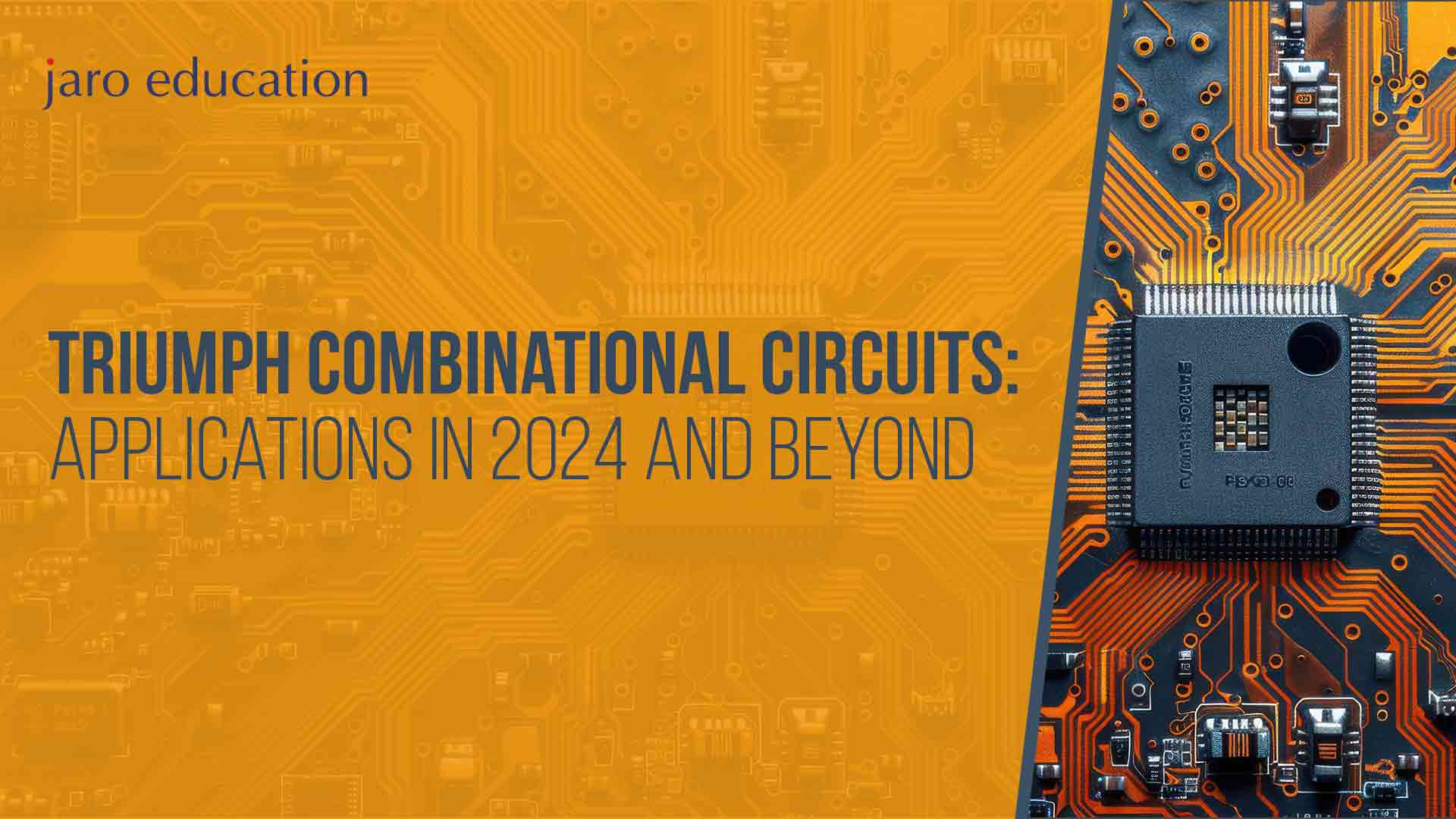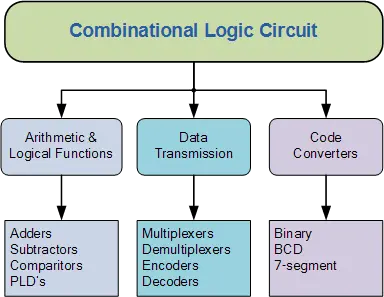Triumph Combinational Circuits: Applications in 2024 and Beyond
Table of Contents

- jaro education
- 10, August 2024
- 6:00 pm
Combinational circuits are essential components in digital electronics that process inputs to generate outputs based solely on the current state of inputs, without storing any previous input or output information. These circuits are fundamental in various applications where immediate processing of data or logic is required. This comprehensive blog explores the fundamentals of combinational circuits, their types, design principles, practical applications across different fields, and future trends shaping their evolution in digital technology.
Combinational logic circuits represent a fundamental aspect of digital electronics, leveraging Boolean logic to process inputs and generate outputs without any internal state storage or feedback mechanisms. Unlike sequential circuits that incorporate memory elements such as flip-flops, combinational circuits operate solely based on the current combination of inputs, making them suitable for tasks requiring immediate data processing.
Components of Combinational Logic Circuits
Combinational logic circuits operate using Boolean logic to process inputs instantaneously and produce outputs based solely on the current combination of inputs. Unlike sequential circuits, which include memory elements like flip-flops, combinational logic circuits do not have feedback loops or state storage. They are composed of basic logic gates, multiplexers, decoders, and encoders to perform arithmetic, logical, and data processing operations in digital systems.
1. Logic Gates
Logic gates serve as the foundational building blocks of combinational logic circuits. These gates include:
- AND Gate: Outputs true (1) only if all inputs are true (1).
- OR Gate: Outputs true (1) if at least one input is true (1).
- NOT Gate: Inverts the input, outputting the opposite value.
- XOR Gate: Outputs true (1) if exactly one input is true (1).
- NAND Gate: Outputs false (0) if all inputs are true (1); otherwise, outputs true (1).
- NOR Gate: Outputs true (1) if all inputs are false (0); otherwise, outputs false (0).
These gates allow combinational logic circuits to perform a variety of logical operations, facilitating tasks such as Boolean algebraic operations and complex decision-making processes.
2. Multiplexers (MUX)
A multiplexer is a key component in combinational logic circuits that selects one input from multiple input lines and forwards it to a single output line. The selection of which input line to transmit to the output is determined by a set of control signals. Multiplexers are commonly used for data routing and selection in digital systems, enabling efficient data processing and control.
3. Decoders
Decoders are combinational logic circuits that convert a binary code applied to their input into a specific set of signals at their output lines. These output signals represent a particular state or condition based on the binary input code. Decoders are essential in digital systems for tasks such as address decoding in memory systems, instruction decoding in microprocessors, and signal decoding in communication systems.
4. Encoders
Encoders perform the opposite function of decoders in combinational logic circuits. They convert multiple input signals into a smaller set of output signals, typically represented in a binary format. Encoders are utilized in applications where efficient data transmission and signal representation are critical, such as in data compression techniques and communication protocols.
Types of Combinational Circuits
Combinational circuits encompass a variety of types based on their structure and functionality, each serving specific purposes in digital electronics. For those interested in delving deeper into digital electronics and VLSI design, the Certificate Programme in Digital VLSI Design by CEP, IIT Delhi offers comprehensive training in advanced digital design techniques, equipping participants with the skills to design and optimize complex integrated circuits for various applications.

*Electronics Tutorials
1. Adders and Subtractors
Adders and subtractors are fundamental arithmetic circuits used to perform addition and subtraction operations on binary numbers. They are essential components in digital computers, microprocessors, and arithmetic logic units (ALUs). Adders can be half-adders (adds two single-bit binary numbers) or full-adders (adds two binary numbers along with a carry input).
2. Multiplexers and Demultiplexers
Multiplexers (MUX) are combinatorial circuits used for data selection and distribution across multiple input channels to a single output channel based on control signals. They efficiently route data in digital systems, allowing for the selection of specific data inputs for further processing or transmission.
Demultiplexers perform the opposite function of multiplexers, distributing a single input to multiple output channels based on control signals. They are crucial in applications requiring data distribution or signal routing.
3. Encoders and Decoders
Encoders convert multiple input signals into a smaller set of output signals, typically in a binary format. They are used in applications where efficient data transmission and signal representation are crucial, such as in communication systems and digital data compression techniques.
Decoders, on the other hand, decode a binary code applied to their input into a specific set of output signals. They are integral in tasks such as address decoding in memory systems, instruction decoding in microprocessors, and signal decoding in communication protocols.
4. Comparator Circuits
Comparator circuits compare two binary numbers or signals to determine their relationship, such as greater than (>), less than (<), or equal to (=). They are essential in applications requiring decision-making based on binary comparisons, such as in digital control systems, measurement instruments, and signal processing circuits.
5. Arithmetic Logic Units (ALU)
Arithmetic Logic Units (ALUs) are integrated circuits that perform arithmetic and logical operations on binary numbers. They are central components in microprocessors, calculators, and digital signal processors (DSPs), capable of executing operations like addition, subtraction, multiplication, division, AND, OR, and NOT operations.
Design Principles of Combinational Circuits
Designing efficient combinational circuits involves applying several key principles to optimize circuit performance and functionality:
1. Boolean Algebra
Boolean algebra forms the foundation for designing combinational circuits, utilizing Boolean operations (AND, OR, NOT) to derive logical expressions that represent the behavior of the circuit. These logical expressions define how inputs are processed to produce desired outputs, ensuring accurate and reliable circuit operation.
2. Karnaugh Maps
Karnaugh maps are graphical tools used to simplify Boolean expressions and minimize circuit complexity. By grouping terms and identifying redundancies in Boolean equations, Karnaugh maps facilitate the reduction of the number of logic gates required in the circuit design. This simplification process improves circuit efficiency, reduces power consumption, and enhances overall performance.
3. Gate-Level Minimization
Gate-level minimization involves optimizing the logic design of combinational circuits to reduce the number of logic gates and interconnections. This technique aims to minimize propagation delays, enhance circuit speed, and optimize resource utilization in digital systems. Gate-level minimization techniques include using simpler gate configurations, eliminating unnecessary gates, and optimizing the arrangement of logic gates for optimal performance.
Applications of Combinational Circuits
Combinational circuits play a crucial role in numerous technological domains due to their ability to process data swiftly and efficiently:
1. Digital Computers and Microprocessors
Combinational circuits are integral components of digital computers and microprocessors, performing essential tasks such as arithmetic operations (addition, subtraction), logical operations (AND, OR, NOT), and data manipulation.
2. Digital Signal Processing (DSP)
In DSP applications, combinational circuits are used for real-time signal processing tasks such as filtering, noise reduction, and modulation/demodulation of signals in communication systems.
3. Telecommunications
Combinational circuits are employed in telecommunications systems for encoding and decoding digital signals, multiplexing data streams, and implementing error detection/correction mechanisms.
4. Consumer Electronics
Devices such as calculators, digital clocks, and remote controls utilize combinational circuits for performing arithmetic calculations, controlling functions, and processing user inputs.
5. Automotive Electronics
In automotive applications, combinational circuits are utilized in engine control units (ECUs), anti-lock braking systems (ABS), and vehicle navigation systems for processing sensor data and controlling vehicle functions.
6. Industrial Automation
Combinational circuits play a critical role in industrial automation for controlling machinery, monitoring processes, and implementing safety protocols based on sensor inputs.
Future Trends in Combinational Circuits
As technology advances, the demand for faster, more efficient combinational circuits continues to grow. Future trends include:
Integration with AI and Machine Learning
Incorporating combinational circuits into AI hardware accelerators represents a significant advancement in optimizing neural network processing. AI applications, particularly deep learning models, rely heavily on matrix multiplications and activation functions, operations that can be efficiently implemented using combinational circuits. By integrating these circuits into AI hardware accelerators, such as GPUs and TPUs, researchers aim to enhance computational efficiency, reduce power consumption, and enable faster inference and training times. This integration is crucial for scaling AI applications across diverse industries, from healthcare diagnostics to autonomous vehicles, where real-time decision-making and processing of vast datasets are essential.
Quantum Computing
In the realm of quantum computing, combinational circuit design principles are being explored to harness the unique properties of quantum mechanics. Quantum circuits, which utilize quantum bits (qubits) and quantum gates, offer unprecedented computational power and parallelism compared to classical digital circuits. Combinational logic designs adapted for quantum computing applications focus on optimizing quantum gate operations, minimizing quantum error rates, and developing quantum algorithms for tasks such as cryptography, optimization problems, and material simulations. This exploration opens new frontiers in computational capabilities, paving the way for breakthroughs in fields where traditional computing faces limitations.
Internet of Things (IoT)
Designing low-power combinational circuits tailored for IoT devices is critical for enabling real-time data processing and communication in interconnected systems. IoT devices operate under stringent power constraints while needing to process and transmit data efficiently. Combinational circuits optimized for low-power consumption can perform tasks such as sensor data aggregation, protocol processing, and edge computing operations directly within IoT devices. This capability enhances the responsiveness and autonomy of IoT deployments, enabling smart cities, industrial automation, and environmental monitoring systems to operate seamlessly and autonomously.
Conclusion
Combinational circuits are foundational components in digital electronics, enabling rapid processing of inputs to produce immediate outputs based on Boolean logic functions. Their versatility and applicability span across diverse industries, from digital computers to telecommunications and automotive electronics. Understanding the principles and applications of combinational circuits is essential for engineers and researchers aiming to advance digital technology and innovate in the digital age.
By mastering the design and implementation of combinational circuits, engineers can contribute to developing faster, more efficient electronic systems that drive technological progress and address complex challenges in the digital era.
In conclusion, combinational circuits represent a cornerstone of digital technology, facilitating essential functions across various applications and paving the way for future innovations in the realm of digital electronics.












